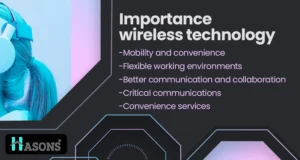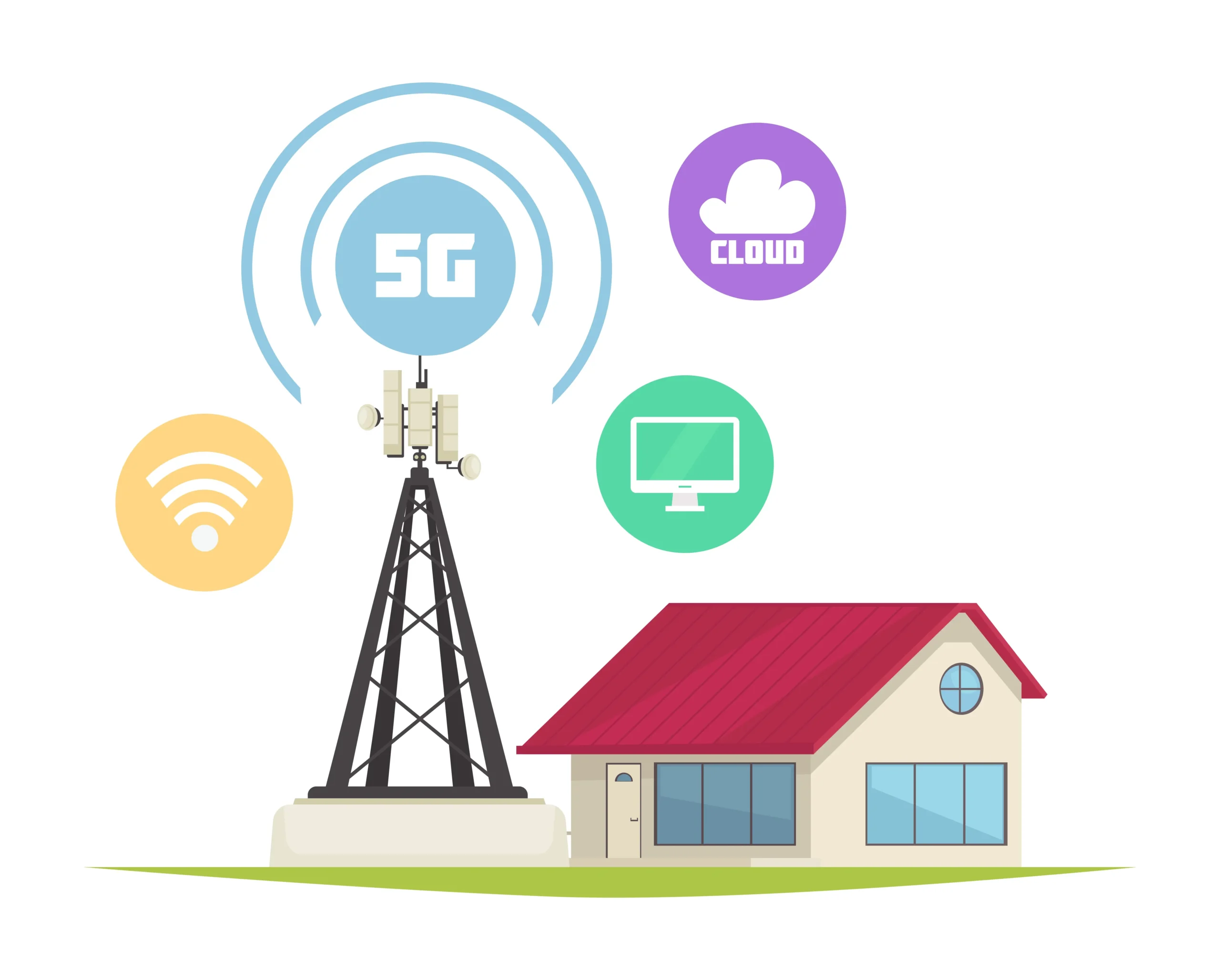Wireless Technology – What is Wireless Technology?
Wireless technology refers to any type of telecommunication or data transfer that occurs without the use of wires or cables. Instead, wireless technology utilizes radio waves or infrared to transmit information and data between devices.
Wireless technology has become an integral part of both personal and business communications in the modern world. It enables us to access information and communicate from virtually anywhere at any time. Devices like smartphones, tablets, laptops, and other gadgets can connect to the internet and communicate through various wireless networking standards and communication protocols.
Importance of Wireless Technology
Wireless technology has become vitally important for both businesses and regular consumers. Here are some of the key reasons why wireless technology is so important:

1.Mobility and Convenience
Wireless devices give us mobility and convenience. Smartphones, laptops, tablets, and other wireless gadgets allow us to access information and services, and communicate from anywhere we want, untethered by cables and wires. This boosts productivity as tasks can be accomplished on the go.
2.Flexible Working Environments
Wireless networks allow employees and businesses to work productively from locations besides the traditional office space. This remote working capability enables flexible working hours and arrangements.
3.Better Communication and Collaboration
The ability to communicate on the move has led to better collaboration between coworkers, partners, clients, and organizations. Messages and information can be exchanged quickly leading to faster turnaround times.
4.Critical Communications
First responders like paramedics and fire crews rely on wireless technology for critical communications when responding to emergency situations out in the field. The reliability and extensive coverage of wireless networks save crucial time and speed up emergency response.
5.Convenience Services
From retail stores to banks, airports, gas stations, and more – wireless technology powers a host of self-service options, kiosks, and interactive guides that facilitate quicker and more personalized services for users.
Benefits of Wireless Technology
Let’s look at some of the major benefits that wireless technology provides:
Mobility
As mentioned before, wireless technology enables mobility by unchaining devices from fixed connections. Laptops, smartphones, headphones, tablets, and similar gadgets can be freely moved without worrying about tripping over a mass of cables.
Convenience
The convenience aspect simply cannot be overstated. Wireless powers an immense number of services, devices, and capabilities that deeply integrate into both regular and work life. From being able to work while traveling, to controlling smart home devices with a smartphone, it massively simplifies life.
Low Installation Cost
Setting up wired networks can involve substantial infrastructure and labor costs for installing cables throughout locations. Wireless networks only require access points or routers to transmit signals. This significantly cuts infrastructure and cabling costs.
Scalability
Wireless networks have excellent scalability as expanding coverage mainly involves adding more wireless access points. This allows starting small with room for easy growth, an attractive quality for businesses aiming to serve growing needs.
Reliability
Modern business-grade wireless equipment and the latest Wi-Fi standards like Wi-Fi 6 offer incredibly reliable connections. Combined with cellular data as an alternative and backups, wireless enables constant connectivity.
Productivity
All the benefits mentioned above, directly and indirectly contribute to greater productivity – the key reason businesses invest heavily in wireless technology. Employees can work without location constraints, teams can collaborate better, and personnel can always be digitally connected.
Future Innovation
Many futuristic technologies rely on wireless connectivity to enable functionality. Be it self-driving vehicles, IoT ecosystems, automation apps, or robotics – they depend on reliable wireless networking. This drives immense innovation across such leading-edge fields.

How Wireless Technology Helps Manufacturing
For a long time, manufacturing depended solely on wired networks due to perceptions that wireless networks lacked reliability and speed. However modern wireless standards have the capacity and dependability to meet manufacturing needs. This makes wireless technology the perfect complement to advancing Smart Factory and Industry 4.0 initiatives.
Here are some of the major benefits wireless provides to manufacturing:
Flexibility
Wireless networks provide extensive coverage across large factory floors and work areas without requiring costly wiring throughout facilities. This enables easily reconfigurable production lines, flexible plant layouts, and mobile workstations.
Mobility
Wireless allows unconstrained mobility of industrial machines like automated guided vehicles (AGVs) and collaborative robots that can freely move to different production areas. Workers also benefit from mobile access to information and instructions wherever needed.
Real-Time Data
IoT sensors that wirelessly stream real-time equipment performance, production metrics, and other operational data power smarter automation through rapid feedback. Managers can proactively address issues based on analytics dashboards.
Asset Tracking
RFID tags and indoor location tracking enable real-time visibility over equipment, tools, components, and other assets. This raises efficiency and minimizes losses or theft.
Reduced Downtime
Downtimes are hugely reduced through better preventative maintenance aided by the timely data insights that wireless systems enable. Problems can be preemptively fixed before causing extended outages.
Safety & Security
Wireless video surveillance paired with AI/ML algorithms improves physical security and also enables automated hazard identification that triggers alerts – improving worker safety.
Advantages of Wireless Technology
Let’s recap the major advantages that wireless technologies provide:
- Enables mobility and convenience by removing locational constraints
- Provides flexible working environments and arrangements
- Lowers installation costs compared to wired networks
- Easy to scale networks to serve additional users and devices
- Modern standards like Wi-Fi 6 offer rock-solid reliability
- Boosts productivity by enabling ubiquitous communication/collaboration
- Essential foundation to utilize futuristic technologies like AI/ML, IoT, etc.
- Powers efficiency-enhancing capabilities for verticals like manufacturing
- Leverages real-time data insights to drive smarter automation
- Critical for first responders and emergency/disaster response
Challenges With Wireless Technology
While wireless technology provides immense advantages, some key challenges exist:
Limited Bandwidth
Bandwidth capacities on wireless networks are lower compared to wired networks. However, new standards like Wi-Fi 6 and 5G continue to expand capacity.
Battery Life Constraints
The utility of smartphones, tablets, and other battery-powered gadgets depends greatly on battery technology. More wireless usage drains batteries faster. Improvements in battery densities are slowly overcoming this.
Security Risks
The open nature of airwaves used for wireless transmission poses risks like snooping or hacking of data. Robust encryption on modern networks minimizes this concern.
Reliability Issues
Adverse weather conditions or interference from equipment can temporarily disrupt wireless signals. Failover connections to cellular data networks often compensate for Wi-Fi downtime.
Health Worries
Some people worry that long-term exposure to electromagnetic radiation from wireless devices may impact human health. However, modern gadgets emit low-energy radiation well within declared safe levels.
Types of Wireless Network Technologies
There are several major categories of wireless network technologies:
Wi-Fi
Wi-Fi is the popular wireless networking standard built on various IEEE 802.11 specifications that enables short-range high-speed internet and networking. Public hotspots and home/office wireless networks predominantly utilize Wi-Fi.
Cellular Data Networks
Cellular data networks (3G, 4G, 5G, etc.) provide wireless internet connectivity through telecom operator signals covering large areas. Smartphones and cellular-equipped tablets/laptops use such networks when Wi-Fi is unavailable.
Bluetooth
Bluetooth is a standard used for short-range wireless connections between smartphones and peripherals like wireless headphones/earbuds, speakers, car infotainment systems, fitness trackers, and more.
Zigbee
Zigbee is the leading wireless standard behind IoT devices like smart home equipment, consumer electronics, healthcare gear, and industrial automation tech. It allows battery-powered networked devices to be remotely monitored and controlled.
Li-Fi
Li-Fi (Light Fidelity) is an emerging wireless optical networking technology that utilizes visible light and LEDs for high-speed networking and connectivity similar to Wi-Fi.
LoRaWAN
A wide area networking protocol designed for the low power, low data rate connectivity required by IoT sensors across expansive areas like cities, forests, or farms.
The Evolution of Wireless Technology
Wireless technology has rapidly evolved from humble beginnings to become an essential utility impacting nearly all walks of life today. Here is a brief history chronicling the major milestones behind wireless tech:
Early Days of Radio: 1895 – 1920s
The pioneering experiments by Guglielmo Marconi, Jagdish Chandra Bose, and Nikolai Tesla demonstrated the possibility of radio-based wireless telecommunications. This planted the first seeds eventually leading to modern wireless tech.
Car Telephones to 0G: 1940s – 1960s
The post-WW2 decades saw further advancements in radio and wireless telephony including car/mobile telephones. By the 1960s, zero-generation (0G) fully automated mobile networks started rolling out in countries like Sweden and Japan.
1G: 1970s
The 1970s saw the launch of the earliest first-generation (1G) cellular networks offering basic mobile voice calling. Despite the massive phones and minimal capacity, it was the proof of concept that paved the path ahead.
2G Digital Networks – GSM & CDMA: 1990s
2G took mobility mainstream thanks to digital networks that enhanced call quality and capacity through new technology standards like GSM and CDMA. This supported text messaging, voicemail, and basic data services kicking off the mobile revolution.
3G Ushers In Mobile Internet: 2000s
The iconic launch of 3G mobile networks with enhanced data capacity rates unlocked a new dimension for phones – mobile internet connectivity. Web browsing, maps, and multimedia officially became mobile.
Wi-Fi Takes Over Wireless Networking: 2000 Onwards
While cellular advances empowered mobility, short-range wireless took major leaps through the Wi-Fi family of standards. This drove Wi-Fi’s dominance powering wireless networking to the levels crucial in the modern tech landscape.
4G LTE Data Networks: 2010 Onwards
4G LTE represented a quantum leap in mobile internet speeds and capacity, making media-rich services like streaming HD video, high-res imaging, and graphical apps viable on mobile devices. It made smartphones nearly indispensable.
5G NR & Wi-Fi 6: Present Day
We currently stand on the cusp of the next era powered by new long-range and short-range wireless standards 5G New Radio and Wi-Fi 6 promising massive capacity, high speeds, and low latency connectivity to technologies like self-driving cars, cloud gaming, and industrial automation.
The accelerating evolution of wireless tech will undoubtedly bring even more amazing capabilities over the coming years through newer standards like 6G, LiFi, and more that SHALL empower innovations not yet imagined!
Conclusion
Over little more than a century, wireless has progressed in leaps from Marconi’s first spark gap experiments to connecting billions across the planet today. The latest 5G and Wi-Fi 6 standards now promise to accelerate this growth further by empowering everything around us with high-speed wireless connectivity.
Truly we have stepped into a hyper-connected world with endless possibilities! While challenges like security, health impacts, and battery limitations remain, the diligent efforts of networks, protocols, encryption, and hardware shall help overcome them.
| If you are reading Wireless Technology then also check our other blogs: | |
| Characteristics of computer system | Wireless Network |
| Types of Internet Connection | Internet in Hindi |
Wireless Technology
- What is the purpose of wireless technology?The purpose of wireless technology is to enable the convenient transfer of data and communication signals across devices without cumbersome wires. This allows enhanced mobility and flexibility.
- What was the first wireless technology?While various pioneers experimented with radio wireless communication in the late 1800s, the first practical application is considered to be Marconi's demonstration of the wireless telegraph in the 1890s for ship-to-shore messaging.
- What are the different wireless technology standards used today?The major wireless standards used in modern tech include cellular networks (5G, 4G LTE), Wi-Fi protocols (802.11n/ac/ax), Bluetooth, and increasingly IoT protocols like Zigbee and LoRaWAN powering connected appliances, robots, self-driving vehicles, and industrial equipment.
